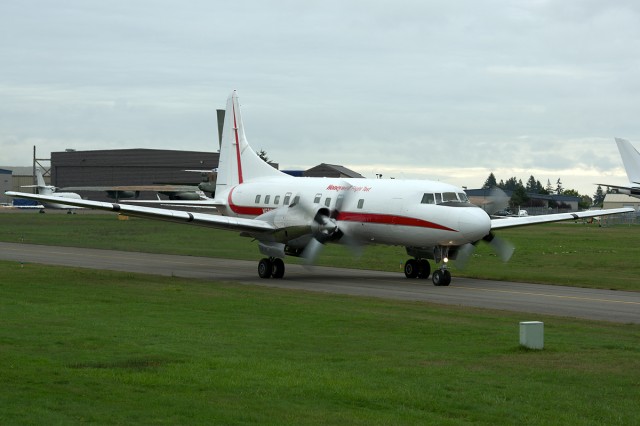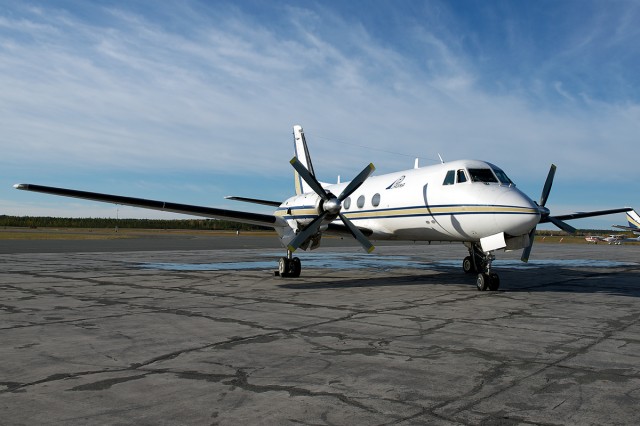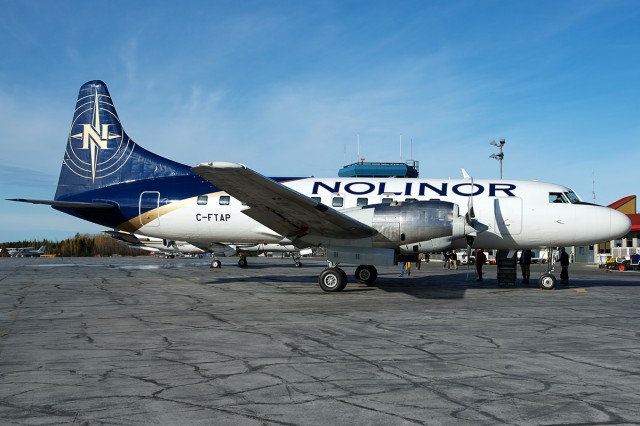
N580HW, a 61-year-old Convair 580 – Photo: Bernie Leighton | AirlineReporter.com
Those of us in the Seattle AvGeek scene are all too familiar with Honeywell Aerospace Flight Test’s Convair 580 (reg N580HW) based at Paine Field (PAE) [where Boeing makes their 747, 767, 777 (for now) & most 787 aircraft]. The aircraft is serial number 2, it was built in 1952. It is not every day that you have the opportunity to see a 61-year-old aircraft in operational service, let alone fly on one. This was my lucky day.
Before making the drive to the “Honeywell Museum of Flight” at Paine Field, I was at Honeywell’s Redmond laboratory to partake in a demonstration of Honeywell’s advanced Enhanced Ground Proximity Warning System (EGPWS), Traffic Collision Avoidance System (TCAS), and landing monitoring research.
At the time, I was not sure if I would be getting a flight on the Convair or their Sabreliner (N670H). Shortly after my arrival, I was told that we would all be hopping aboard N580HW — I was thrilled, but also at the same time kind of jealous of the Sabre crew!

C-FAWE, Propair’s only Gulfstream I. It was U/S at CYUY. Photo: Bernie Leighton | AirlineReporter
In between scheduled flights, I found a Propair employee. I asked him all of one question: “Can I take a look around the Gulfstream?”
His answer, as far as I could tell, was yes.

One of Nolinor’s Convair 580s on the ramp at Rouyn-Naranda – Photo: Bernie Leighton | AirlineReporter.com
April 1956 represented a different era in aviation. Local service airlines were popular, fares were regulated, and people still dressed-up to fly. It was also when the three hundred thirty-fourth Convair 440 rolled off the assembly line to start service with Canadian regional airline Time Air.
The Convair 440 was built to American Airlines’ specifications to serve as a pressurized DC-3 replacement. It was equipped with Pratt & Whitney Double Wasp engines and three-bladed propellers, weather radar and a few other features that distinguished it from the original 240s.
After entering service, the Allison Engine Company (now a division of Rolls Royce) devised an offering to re-engine Convair 440s with T56 turbines (the same engine as the Lockheed C-130, P-3 Orion, and Electra II). This added thousands more shaft horsepower, and allowed for not only greater range, but a higher cruising altitude. The conversions were done by Pacific Airmotive and could be done in as short as sixty days.
Time Air sold line number 334 to Canair Cargo, who proceeded to park it in 1998. Nolinor Aviation purchased the airframe and converted it back to passenger use later that year. Throughout the years, the registration has remained the same; C-FTAP. Recently, I had the opportunity to fly on this classic bird.


